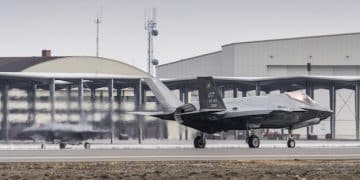Defense Investment: VC Bets in 2025’s Defense Landscape

Venture capital firms, traditionally risk-averse in the defense sector due to long development cycles and specialized clientele, are increasingly turning their focus toward defense technology, specifically identifying agile startups developing dual-use technologies, AI, autonomy, and advanced materials as promising investment avenues for 2025.
In a rapidly evolving geopolitical landscape, the question of Defense Industry Investment: Where are Venture Capital Firms Placing Their Bets in 2025? is more pertinent than ever. While historically cautious, venture capital (VC) is now engaging with the defense sector, seeking disruptive innovations that promise both security and significant returns.
The Evolving Landscape of Defense Investment
The traditional defense procurement model, often characterized by lengthy cycles and large, established contractors, is encountering a new dynamic. Geopolitical shifts, rapid technological advancements, and the imperative for real-time adaptability are compelling defense ministries worldwide to seek innovative solutions beyond conventional channels. This evolving environment has inadvertently opened doors for venture capital, pushing them to reassess a sector once deemed too slow and regulated for nimble startup investments.
Venture capitalists are increasingly recognizing that the defense sector is no longer exclusively the domain of legacy aerospace and defense giants. The rise of agile startups, capable of developing cutting-edge technologies at unprecedented speeds, presents a compelling investment thesis. These smaller entities often leverage commercial off-the-shelf (COTS) components and agile development methodologies, allowing them to rapidly prototype and iterate, something larger defense contractors struggle to emulate due to their inherent structural complexities.
Moreover, the concept of “dual-use” technologies has become a powerful magnet for VC interest. Innovations in areas like artificial intelligence, machine learning, robotics, and advanced materials often have immediate commercial applications while simultaneously offering significant advantages for defense and national security. This dual applicability mitigates some of the traditional market risks associated with purely defense-focused ventures, making them more attractive to investors seeking broader market potential and faster returns.
Government initiatives are also playing a crucial role in de-risking defense tech investments for VCs. Programs designed to streamline procurement, offer early-stage grants, and foster public-private partnerships are creating a more favorable ecosystem. These initiatives help bridge the “valley of death” that many defense startups face, from initial R&D to full-scale production and adoption. By providing a clearer path to market and demonstrating a commitment to embracing new technologies, governments are signaling a shift that venture capitalists are keen to capitalize on.
In essence, what we are witnessing is a maturation of the defense technology ecosystem, driven by both necessity and opportunity. The strategic convergence of commercial innovation, national security imperatives, and government support is reshaping investment patterns, positioning the defense industry as a burgeoning frontier for venture capital in 2025 and beyond.
The imperative for agility and technological superiority in modern warfare means that venture capital, with its appetite for disruption and rapid growth, is becoming an indispensable partner in advancing defense capabilities. This evolving partnership is fundamental to understanding where capital will flow in the coming years.
Artificial Intelligence and Autonomy: The New Frontier
The intersection of artificial intelligence (AI) and autonomous systems represents one of the most significant investment hotbeds within the defense industry for 2025. Venture capital firms are pouring resources into startups that are pushing the boundaries of what is possible in areas ranging from intelligent surveillance to automated decision-making and robotic warfare.
AI-Powered Decision Making
AI’s ability to process vast amounts of data at speeds impossible for humans is transformative for defense. VCs are keen on technologies that can enhance situational awareness, predict adversary movements, and optimize logistical operations. This includes sophisticated analytical platforms and tools for intelligence gathering and interpretation.
- Predictive analytics for threat assessment.
- AI-driven platforms for real-time intelligence fusion.
- Automated reconnaissance and surveillance.
Autonomous Systems and Robotics
Autonomous systems, free from continuous human control, are revolutionizing battlefield dynamics. This includes drones (aerial, terrestrial, and maritime), unmanned ground vehicles (UGVs), and sophisticated robotic platforms. VCs are looking for innovations that offer enhanced endurance, precision, and operational efficiency without putting human lives at risk.
- Advanced swarm intelligence for multi-robot coordination.
- Robotics for hazardous environment operations (e.g., EOD, chemical warfare).
- Next-generation autonomous navigation and perception systems.
The value proposition for AI and autonomy lies in their potential to reduce human casualties, increase operational tempo, and manage complex environments with unprecedented efficiency. Investment in these areas is driven by both the immediate tactical advantages they offer and their long-term potential to redefine military doctrine. Venture capitalists are seeking companies with novel algorithms, robust data infrastructure, and demonstrated capabilities in deploying these technologies in challenging real-world scenarios. The dual-use potential is particularly strong here, as many AI and robotics advancements for defense also have clear applications in logistics, disaster response, and critical infrastructure management, broadening their market appeal.
Cybersecurity and Secure Communications
In an increasingly interconnected world, where every piece of military hardware and communication network is a potential target, cybersecurity and secure communications have surged to the forefront of defense investment priorities. Venture capital understands that the integrity of information and the resilience of networks are as crucial as physical capabilities.
The threat landscape is expanding, with sophisticated state-sponsored attacks, cyber-terrorism, and industrial espionage becoming ever more prevalent. This creates an urgent demand for advanced cybersecurity solutions that can protect critical infrastructure, sensitive data, and command-and-control systems from compromise. VCs are scouting for startups that offer truly innovative approaches, moving beyond traditional perimeter defense to embrace proactive, adaptive, and resilient security architectures.
Next-Generation Cybersecurity Defenses
Investment is flowing into technologies that utilize AI and machine learning for threat detection and response, quantum-resistant cryptography, and zero-trust architectures. The focus is on solutions that can identify and neutralize threats in real-time, even those that exploit previously unknown vulnerabilities. The ability to operate effectively in contested cyber environments is a key differentiator for these companies.
- AI-driven threat intelligence and anomaly detection.
- Quantum-safe encryption methods.
- Zero-trust network access solutions for distributed environments.

Building Resilient and Secure Communication Networks
Secure communications are not just about encryption; they encompass a holistic approach to network resilience, jamming resistance, and low-latency data transfer in challenging environments. VCs are interested in satellite communication startups, Mesh networking technologies, and secure 5G solutions tailored for military applications. The goal is to ensure uninterrupted and protected information flow, from the tactical edge to strategic command centers, regardless of external interference.
- Low-earth orbit (LEO) satellite constellations for robust data links.
- Tactical mesh networks for secure, decentralized battlefield communication.
- Secure software-defined radio (SDR) technologies.
The strategic importance of maintaining information dominance and safeguarding operational networks cannot be overstated. Venture capital firms are not merely investing in products but in the foundational elements that will define the next generation of military operations. Companies that can demonstrate a clear advantage in securing complex digital ecosystems and ensuring absolute communication integrity are positioned to attract significant capital in 2025, driven by the imperative to protect against evolving digital threats and maintain strategic superiority.
Advanced Materials and Manufacturing
Innovation in advanced materials and manufacturing processes is quietly revolutionizing the defense industry, offering breakthroughs in weight reduction, strength, durability, and cost-effectiveness. Venture capital firms are increasingly recognizing the profound impact these foundational technologies can have across various defense applications, from lighter, more resilient airframes to enhanced protective gear and improved projectile performance.
The drive for superior performance often hinges on the materials used. Whether it’s enabling faster, more fuel-efficient aircraft or developing armor that can withstand advanced threats, the underlying chemistry and engineering of materials are critical. Furthermore, new manufacturing techniques, such as additive manufacturing (3D printing), are allowing for the rapid prototyping and production of complex components, reducing lead times and supply chain vulnerabilities—factors highly appealing to the defense sector.
Revolutionary Materials for Defense Applications
VC investments in this space are targeting companies developing novel alloys, composites, ceramics, and metamaterials that exhibit extraordinary properties. These materials can offer benefits such as improved stealth characteristics, enhanced resistance to extreme temperatures or pressure, and significantly reduced overall system weight, which translates directly into better performance and lower operational costs. The dual-use potential here is also substantial, as these material advancements often find immediate application in aerospace, automotive, and medical industries.
- High-strength, lightweight composites for aerospace and ground vehicles.
- Self-healing materials for extended operational life.
- Advanced ceramics for ballistic protection and heat shields.
Additive Manufacturing and Rapid Prototyping
Beyond materials themselves, advancements in manufacturing methodologies are drawing significant VC attention. Additive manufacturing, or 3D printing, is a game-changer for defense. It allows for on-demand production of highly complex parts, customizable designs, and localized manufacturing, which can drastically shorten supply chains and enable rapid field repairs. This agility and resilience are invaluable to military operations.
- Metal 3D printing for critical component production.
- On-demand parts fabrication in austere environments.
- Personalized protective equipment manufacturing.
The appeal for venture capital in advanced materials and manufacturing lies in their cross-cutting applicability and their potential to unlock entirely new design possibilities and operational paradigms. Companies that can deliver significant improvements in material properties or revolutionize production methods are seen as foundational innovators, capable of generating substantial returns by enhancing core defense capabilities and addressing critical logistical challenges. The focus is on disruptive technologies that offer a clear advantage in performance, efficiency, and supply chain resilience, making this a pivotal area for investment in 2025.
Space-Based Capabilities and Satellite Technology
The space domain has rapidly emerged as a critical arena for both national security and commercial innovation, attracting substantial venture capital interest. The proliferation of low-earth orbit (LEO) satellite constellations, combined with advancements in satellite design and launch capabilities, is transforming how defense, intelligence, and communication operations are conducted. VCs are betting on companies that can provide a decisive edge in space.
Accessibility to space is no longer solely the domain of large government agencies. Private companies are driving down launch costs, miniaturizing satellites, and developing sophisticated payloads, making space a more dynamic and competitive environment. This commercialization of space offers defense entities unprecedented access to real-time intelligence, resilient communication networks, and precise navigation, fueling the enthusiasm of venture capitalists.
Developing Advanced Satellite Constellations
Investment is heavily concentrated in companies designing, launching, and operating next-generation satellite constellations. These are not merely about broadband internet; they are about persistent global surveillance, enhanced tracking capabilities, and secure, jam-resistant communications for military forces operating anywhere on Earth. VCs are particularly interested in the scalability and resilience offered by distributed LEO constellations compared to traditional, monolithic satellites.
- High-resolution Earth observation and intelligence satellites.
- Secure, low-latency communication networks via LEO.
- Satellite-based missile early warning and tracking systems.

Innovations in Space Situational Awareness and Resilience
As more assets are deployed in space, the need to track, protect, and maintain operational superiority becomes paramount. VCs are investing in technologies that enhance space situational awareness (SSA), counter-space capabilities, and on-orbit servicing. These innovations ensure the longevity and effectiveness of satellite assets, safeguarding critical national security infrastructure against threats and debris. The ability to monitor orbital traffic, predict collisions, and even service satellites in orbit represents a significant leap in space resilience.
- Advanced ground and space-based sensors for SSA.
- Orbital debris mitigation and removal technologies.
- On-orbit refueling and repair services for extended satellite life.
The strategic importance of space to modern defense cannot be overstated. Venture capital firms are seizing the opportunity to invest in companies that are not just participating in the space economy but actively shaping its future and providing crucial capabilities for national security interests. The dual-use nature of many satellite technologies—from climate monitoring to global positioning for civilian applications—further enhances their investment appeal, offering diversified revenue streams alongside defense contracts, making this a prime area for sustained VC interest in 2025.
Emerging Threats and Countermeasures
The nature of warfare and global conflict is continually evolving, with new threats emerging that defy traditional defense paradigms. This dynamic environment is creating significant opportunities for venture capital to invest in innovative countermeasures that address these novel challenges. From hypersonic weapons to sophisticated drone swarms and bio-threats, the defense industry is in urgent need of agile, advanced solutions, and VCs are keen to fund the companies developing them.
Traditional defense R&D cycles can be slow, often lagging behind the rapid pace of threat evolution. This gap presents a fertile ground for startups that can quickly prototype and deliver cutting-edge solutions. Venture capitalists are looking for companies that offer disruptive technologies capable of anticipating and neutralizing threats before they escalate, providing a strategic advantage rarely found in established defense ecosystems.
Defending Against Hypersonic Weapons
Hypersonic missiles, capable of traveling at speeds greater than Mach 5 and executing complex maneuvers, pose a significant challenge to existing air and missile defense systems. VCs are backing startups developing advanced sensors, interceptor technologies, and sophisticated command-and-control systems specifically designed to detect, track, and engage these high-speed threats. This involves cutting-edge radar, infrared, and AI-driven predictive analytics.
- Hypersonic missile detection and tracking systems.
- Advanced interceptor technologies.
- AI-driven battle management systems for rapid response.
Counter-UAS and Anti-Swarm Technologies
The proliferation of unmanned aerial systems (UAS), particularly small, commercially available drones used for nefarious purposes, presents a pervasive and complex threat. Moreover, the emergence of drone swarms, coordinating autonomously, complicates traditional defense. Venture capital is investing in innovative counter-UAS (C-UAS) solutions, including sophisticated electronic warfare, directed energy weapons, and advanced net systems, capable of neutralizing individual drones or entire swarms.
- Directed energy weapons (DEW) for drone neutralization.
- Advanced electronic warfare (EW) for drone jamming and spoofing.
- AI-enabled swarm detection and disruption systems.
Investment in emerging threats and countermeasures reflects a proactive approach to national security. Venture capital firms see the immediate and long-term demand for these technologies, recognizing that the ability to effectively counter novel threats is paramount for maintaining geopolitical stability and protecting critical assets. The companies attracting capital in this space are those that demonstrate not only technical prowess but also the agility to adapt to ever-evolving threat landscapes, making them strategically attractive for 2025 and beyond.
Future Outlook and Strategic Implications
The venture capital shift into the defense industry is not a fleeting trend but a fundamental re-evaluation of a sector ripe for technological disruption. As we look towards 2025 and beyond, the strategic implications of this increased investment are profound, promising to reshape national security landscapes and redefine the public-private partnership in defense innovation. This trend is driven by a confluence of geopolitical necessity, technological maturity, and evolving investment appetites.
The military-industrial complex of the future will likely be characterized by a more diverse ecosystem, where agile startups funded by VCs play a significant role alongside established defense primes. This diversification is crucial for fostering faster innovation cycles, introducing cutting-edge capabilities more rapidly, and enhancing overall national security resilience. Venture capitalists, by bringing their emphasis on speed, scalability, and market disruption, are acting as catalysts for this transformation.
The Rise of Dual-Use Technologies
The continued emphasis on dual-use technologies will attract a broader spectrum of VC firms, those that might traditionally shy away from purely defense-focused ventures. This approach mitigates risk by providing commercial revenue streams, making defense tech investments more palatable. Expect to see further blurring of lines between commercial tech and defense applications, with innovations in AI, quantum computing, biotechnology, and advanced energy storage finding utility across both sectors. This trend encourages a virtuous cycle of innovation, where defense benefits from commercial research, and vice versa.
- Increased collaboration between tech hubs and defense agencies.
- Faster transition of cutting-edge research into deployed systems.
- Diversification of defense supply chains beyond traditional contractors.
Geopolitical Imperatives and Competitive Advantage
Global instability and heightened competition among peer nations will continue to fuel defense spending and, consequently, VC interest in technologies that offer a decisive competitive advantage. Nations that successfully foster an environment conducive to defense tech innovation, attracting venture capital and supporting agile startups, will likely gain an edge in maintaining technological superiority and projecting influence.
- Accelerated development of strategic defense capabilities.
- Enhanced deterrence through technological asymmetry.
- New opportunities for international defense tech partnerships.
Ultimately, venture capital’s deep dive into the defense industry in 2025 signifies a mature recognition that national security relies not just on traditional military might but increasingly on technological innovation. The strategic implications are clear: a more dynamic, technologically advanced, and resilient defense ecosystem is emerging. This partnership between private capital and public defense is set to redefine capabilities, drive efficiencies, and ensure a competitive edge in a world where technological supremacy often equates to strategic advantage, ushering in a new era of defense innovation forged by entrepreneurial spirit and investment foresight.
| Key Area | Brief Description |
|---|---|
| 🤖 AI & Autonomy | Investment in intelligent systems, robotics, and advanced decision-making for efficiency and reduced risk. |
| 🔒 Cybersecurity | Focus on protecting critical infrastructure and communications from evolving digital threats. |
| 🚀 Space Tech | Developing advanced satellite constellations and space situational awareness capabilities. |
| 🛡️ Countermeasures | Funding solutions for new threats like hypersonic weapons and advanced drone swarms. |
Frequently Asked Questions About Defense Tech Investment
VC firms are drawn to defense due to rapid technological advancements, geopolitical tensions creating demand, and the rise of dual-use technologies applicable in both commercial and military sectors. Government initiatives to streamline procurement also make the sector more attractive, reducing historical barriers and offering clearer pathways to market for innovative startups in defense tech.
Dual-use technologies are innovations developed with both commercial and military applications. Examples include AI algorithms, advanced robotics, sophisticated sensors, and secure communication systems. Their dual nature makes them attractive to VCs as they offer broader market potential and can mitigate some of the market risks associated with purely defense-focused investments, facilitating faster returns.
For 2025, VCs are prioritizing Artificial Intelligence and Autonomy (e.g., intelligent systems, robotics), Cybersecurity and Secure Communications, Advanced Materials and Manufacturing (e.g., 3D printing, novel composites), Space-Based Capabilities (e.g., LEO satellites), and solutions for Emerging Threats and Countermeasures (e.g., anti-hypersonic and counter-UAS systems).
VC investments accelerate the development and deployment of critical defense technologies, fostering innovation and agility within the defense sector. This leads to enhanced capabilities, diversified supply chains, and improved technological superiority, ultimately strengthening national security by providing advanced tools to counter evolving threats and maintain a strategic advantage on a global scale.
Defense tech startups face challenges such as long product development cycles, complex regulatory hurdles, the need for specialized certifications, and reliance on government contracts. While VC interest is growing, these factors can still make it harder for startups to demonstrate quick returns and scalability, requiring investors with a deeper understanding of the defense market’s unique intricacies.
Conclusion: A New Era of Defense Innovation
The increased appetite of venture capital firms for the defense industry heralds a transformative period for national security. What was once a domain dominated by a few large players is now opening its doors to the agility and innovation inherent in the startup ecosystem. As we advance towards 2025, the strategic bets by VCs on AI, autonomy, cybersecurity, advanced materials, and space technologies will not only redefine military capabilities but also strengthen the nexus between commercial ingenuity and national defense. This shift promises a more responsive, technologically advanced, and resilient defense landscape, vital for navigating the complexities of modern global challenges.





